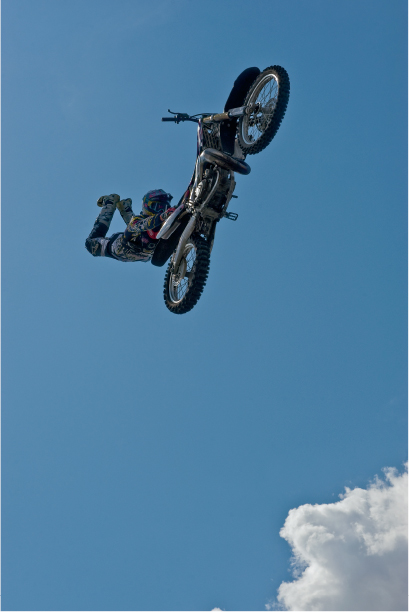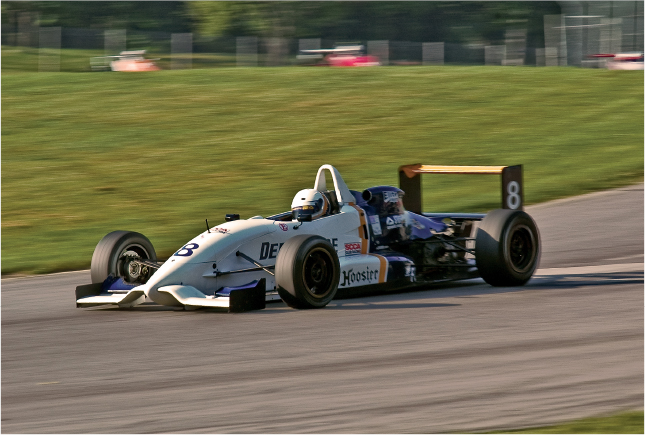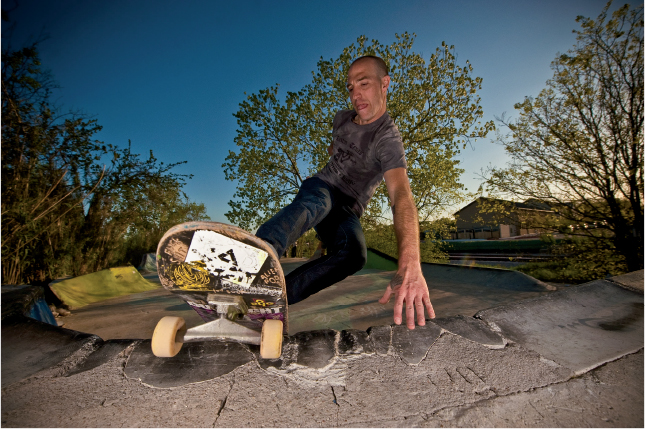CHAPTER 8
Action and Sports Photography
Action photography allows you to freeze a moment in time, which affords the viewer the chance to see the action in a way that's just not possible with the naked eye. This is probably why action and sports photography is so popular.
Generally action photography is associated with some kind of sport, although that doesn't have to always be the case. This type of photography can be done with any type of moving subject, from a pet running up the beach to a child running around at the playground to a professional basketball player slam-dunking the ball.

Catching an athlete at the peak of the trick is the key to a successful action shot.
Preparing Your Shot
Timing is the key to getting a great action shot. You need to capture the peak of the action, and it helps to be familiar with the sport. For example, when photographing a track event such as the 100-yard dash, you know that as the runners come off the starting blocks, there will be strength and energy in their form. Of course, catching the winner crossing the finish line is also a great time for a shot.
The best way to get a feel for the sport you're photographing is quite simply to stand back and watch before you start shooting. Taking a few minutes to be a spectator can allow you to see the rhythm of the action.
Another big part of capturing a great action shot is being in the right place at the right time. While this sounds like luck, it's not. With basketball, for example, you know exactly where the action is going to be 95 percent of the time: right at the basket. With other sports it's not always quite as easy, but as I mentioned previously, watching for a while can give you an idea of where most of the action will be.
Shutter speed is perhaps the most important camera setting for photographing action. The shutter speed determines how the movement is shown in your photograph. For the most part, a fast shutter speed is used when photographing action because it allows you to freeze the motion of the subject. Freezing the motion lets you get a sharp image of an athlete. Take Figure 8.1, for example. I was photographing an extreme cage-fighting event in San Antonio, Texas. The action at this type of event happens very fast. The goal is to freeze the action and to capture the moment of impact, which requires a shutter speed of at least 1/500 second. As you can see from the photo, I was just a tad late in getting the contact, capturing instead the moment just as the fighter pulled his head away, so you can still see the effect of the impact on his face.
The lighting at indoor sports events can be very dim and flash is prohibited, so to get a shutter speed that fast, I had to open up my aperture to f/2.8 and crank my ISO up to 1800. Because this was a cage fight, I also needed to open the aperture wide to provide a shallow depth of field so that the wires from the cage were almost invisible. My other settings were Center-weighted metering, Continuous AF, and a single focus point set to center. The reason I chose Center-weighted metering was that Matrix and Spot metering were giving me unreliable results because the fighters were moving all around the ring and the lighting was constantly changing. Center-weighted metering allowed me to get a good average exposure. I selected a single focus point because there were so many colored elements in the scene; both Dynamic and 3D-tracking were having problems tracking the subject. Of course, because I knew I needed a fast shutter speed, I used Shutter Priority mode.
8.1 Using a fast shutter speed of 1/500 second was absolutely necessary to freeze the motion in this shot. Exposure: ISO 1800 (Auto), f/2.8, 1/500 second using a Nikon 80-200mm f/2.8D lens at 86mm.
Using a fast shutter speed isn't the only way to capture great action shots. Using a slow shutter speed can sometimes be exactly what you need to bring out the movement in an action shot. For example, when shooting any type of motorsports, photographers often use a slow shutter speed to introduce some blurring into the image to illustrate movement.
Panning
In Figure 8.2, I was photographing a Formula car race. As you probably know, race cars are pretty fast, and in order to capture the action, I had to employ a couple of different techniques. I used a relatively slow shutter speed (considering the speed of the subject) and panning. If you're not familiar with panning, it is a technique in which you follow your subject along the same plane that it is traveling. Typically, you pan horizontally. You can also pan vertically, but this can be more difficult and generally isn't done because most action takes place on a horizontal plane.
Panning reduces the relative speed of the subject in relation to the camera, thereby allowing you to freeze the motion of the subject more easily than if you held the camera still and snapped the shot while the subject moved through the frame.
When you are photographing racing cars that are moving at more than 100 mph, using a fast shutter speed sounds like an obvious choice, right? Wrong. Using a fast shutter speed freezes all the movement of the car, including the tires, which are the fastest-moving part of the car. Freezing the motion of the tires causes the car to look like it's sitting parked on the track.
Panning is most effective when used in conjunction with a relatively slow shutter speed. Because the speed of the subject is effectively reduced by the camera movement, you can use a slower shutter speed to freeze the action. In addition to this, because the background effectively moves faster, the slow shutter speed causes the background to have motion blur. The background blur gives your image the illusion of movement and also helps to isolate the subject from the background. In Figure 8.2, I employed a relatively slow shutter speed of 1/125 second using Shutter Priority mode. I say relatively because for most sports, a fast shutter speed is generally 1/250 second or faster. In auto racing, 1/250 second is relatively slow.
Panning can be used with almost any type of moving subjects, from racing horses to runners or even your pet running across the yard.

8.2 I employed a relatively slow shutter speed of 1/125 second using Shutter Priority mode. I panned along with the car to freeze the motion, but the wheels and background are rendered as blurs giving a feeling of motion. Exposure: ISO 200, f/13, 1/125 second using a Nikon 70-200mm f/2.8G VR lens at 185mm.
Using Speedlights
Although in general flash isn't used when shooting sports, sometimes it can add a special effect and help to freeze the action if there isn't a lot of light. In Figure 8.3, I used a completely different technique to freeze action: Speedlights. I used flash to light this skateboarder, but I also kept the background in mind when choosing my settings.
It was late afternoon during the shoot and I was looking to get a very dynamic image; I underexposed the background to make the sky more dramatic and make the image darker for more contrast and saturation.
When I set up for the shot, I knew I wanted an extreme perspective distortion to give the image more impact. I used a Nikon 10.5mm Fisheye lens because its extreme wide angle gives it a really deep depth of field; this makes achieving focus with this lens simple.

8.3 Using uncommon techniques and lenses can give your images more impact. Exposure: ISO 400, f/5.6, 1/60 second using a Nikon 10.5mm f/2.8 fisheye lens.
To get the extreme perspective distortion I was looking for, I had to get pretty close. I got right up to the lip of the ramp and just prayed he wouldn't crash into me! Although he looks like he's a couple of feet away, the skateboard was only about 10 inches from my lens.
![]() Be careful when using wide-angle lenses when photographing moving subjects. Wide-angle lenses make things look farther away than they really are when looking through the viewfinder. What looks like feet to you may actually be inches.
Be careful when using wide-angle lenses when photographing moving subjects. Wide-angle lenses make things look farther away than they really are when looking through the viewfinder. What looks like feet to you may actually be inches.
I first set my camera to Spot metering mode. I then aimed the lens at the brightest spot in the sky, which was just over the horizon. I took the reading, and then I subtracted two stops from it; this was the exposure I was looking for — 1/60 second at f/5.6, which I set in Manual exposure. This is a relatively slow shutter speed for action shots, but I wasn't worried because I was using a Speedlight. The short duration of the flash is often enough to freeze your subject in motion.
I used an SU-800 Speedlight as a commander and an SB-800 Speedlight as a remote to achieve this shot. I set the SB-800 to function as a remote on Group A and used the AS-19 Speedlight stand to attach it to a light stand. I positioned the SB-800 and stand to the right of the camera, just out of sight. I used the built-in wide-angle diffuser to soften the light just a bit and to give the flash a little more coverage.
![]() Before using flash on action shots, be sure to get permission from the athlete. Using a flash may blind him, which can lead to disastrous results.
Before using flash on action shots, be sure to get permission from the athlete. Using a flash may blind him, which can lead to disastrous results.
The first couple of shots I took with straight Through-the-Lens (TTL) weren't quite bright enough to make the rider really stand out, so I adjusted the Flash Exposure Compensation (FEC) on the SU-800 to +2 exposure value (EV). This gave me the amount of light that I was looking for, exposing my subject perfectly while the background was underexposed, which made for a dramatic effect.

